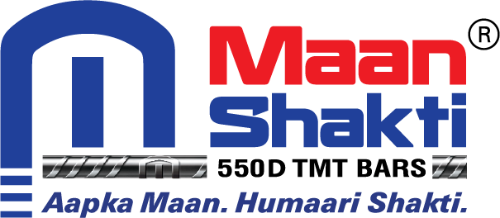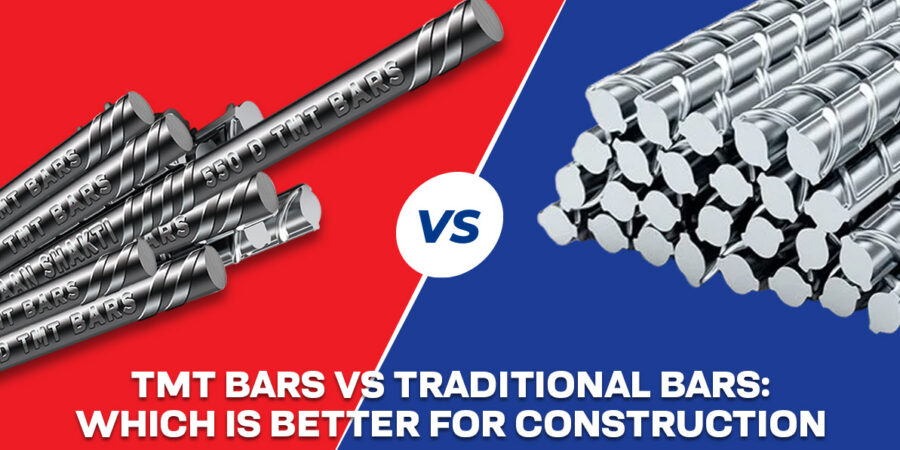The advancement of technology in the 20th century has brought many changes to how buildings are constructed. One of the most significant changes is the introduction of TMT bars. TMT bars and traditional bars are both steel bars used to reinforce concrete structures. “So why are they so drastically different?” some may ask. The difference lies in the manufacturing process and the raw materials.
Let’s take a look at how TMT bars differ from traditional bars. By looking at the differences between them, we can better understand why TMT bars are widely preferred over traditional steel bars.
TMT Bars: Manufacturing Process and Benefits
Thermo Mechanically Treated or TMT bars are high-strength reinforcement bars. The manufacturing process of TMT bars includes a series of processes — rolling, water quenching, atmospheric cooling, and self-tempering. These steps are essential in ensuring the production of the best TMT bars. The quality of TMT bars also depends on factors like the quality of raw materials, rolling mills, and quenching and tempering systems. The best TMT bar manufacturers pay special attention to these steps and factors to produce superior, unmatched products.
Since their introduction in 1979, TMT bars have primarily been used in construction. The construction industry has witnessed many wide-ranging changes thanks to the introduction of TMT bars. The structures built today are remarkably stronger, more durable, and resistant to a lot more environmental factors. These include:
(Source – sreemetaliks )
- Corrosion resistance: The multi-step manufacturing process and the high quality of raw materials needed to manufacture TMT bars attest to its exceptional corrosion resistance. TMT bars can withstand exposure to water for a longer duration than other steel bars used in construction without their quality being affected. Hence, making TMT bars significantly more resistant to pitting and crevice corrosion.
Moreover, TMT bars don’t undergo any physical deformation during manufacture, protecting against corrosion and ensuring the structure’s durability.
- Fire resistance: Advanced quenching techniques make TMT bars able to withstand much more heat than regular reinforced steel bars, significantly reducing instances of fires.TMT bars have higher thermal stability and absorb heat up to 600 degrees Celsius. This allows them to retain more than 80% of ambient temperatures. This feature is of great value in protecting a structure against fire disasters. Seismic resistance:
- Fatigue resistance: The outer layer of TMT bars is extremely strong, giving them high fatigue-resistance power. This allows them to withstand pressure, dynamic loading, and other fatigue-related factors which otherwise pose a risk to the stability of a structure. Similarly, the core of TMT bars is made of ferrite-pearlite. This soft core enables TMT bars to withstand any loading.
- Seismic resistance: The soft ferrite-pearlite core and reinforcement strength add to the tensile strength of structures. This increase in tensile strength allows them to absorb a greater amount of energy released during an earthquake. Therefore, TMT bars are highly suitable for construction in earthquake-prone regions.
TMT bars are highly resistant to breaks and damages that come with bending and rebending. This makes them very easy to work with during a construction project and allows structures to remain firm in the face of natural calamities. They are also very flexible, allowing the bars to 180 degrees without sustaining cracks or breaks.
The best TMT bar manufacturers use raw materials that have a low carbon content, which makes welding a viable option. Moreover, they need no pre or post-welding treatments, adding to the convenience of using TMT bars on construction sites.
Traditional Bars: Manufacturing Process and Benefits
TOR or Toriseg Steel Corporation of Luxembourg are a variety of High Yielding Strength Deformed (HYSD) steel bars. The manufacturing process of these traditionally used steel involves a cold twisting process following the heat treatment. The cold twisting process causes the bars to develop physical deformities. These deformations have several advantages. Let’s look at a few of them.
- Binding properties: The uniform placement of deformations along the steel bar increases the binding properties of concrete and minimises spillage. This ensures excellent stability & durability in structures. Traditional bars also possess high tensile strength owing to this attribute. The unique physical deformation also reduces the need for end hooks in construction.
- Flexibility: Traditional steel bars are flexible thanks to the uniform ribbed physical deformity. They can be bent up to 180 degrees without any cracks or fractures forming.
The advantages of traditional bars don’t end here. Traditional bars can be welded using electric flash butt welding or arc welding. As they can be welded with relative ease, they remained the top choice for construction for many years.
Conclusion
So far, we have comprehensively analyzed the manufacturing processes and the advantages of both TMT bars and Traditional steel bars. While traditional bars do not completely lack benefits, the pros of TMT bars significantly outweigh them. The best TMT bar manufacturers are focusing on making their products eco-friendly as sustainability becomes the need of the moment. TMT bars are recyclable and can be reused without any impact on the quality of the construction. Now you know that in construction of any kind, TMT bars are the best choice! Maan Shakti is a reputed name in the industry for the best TMT bar manufacturers.


